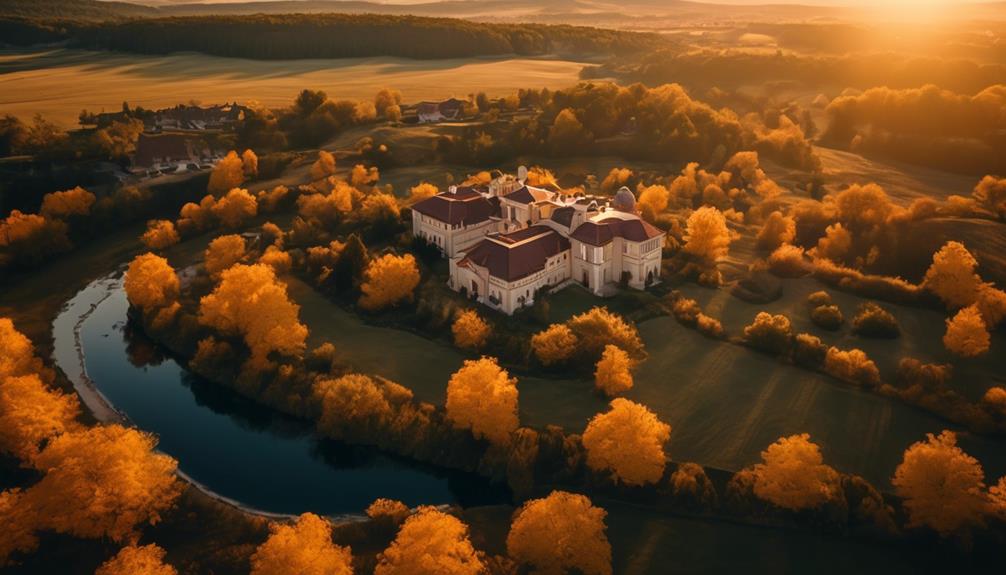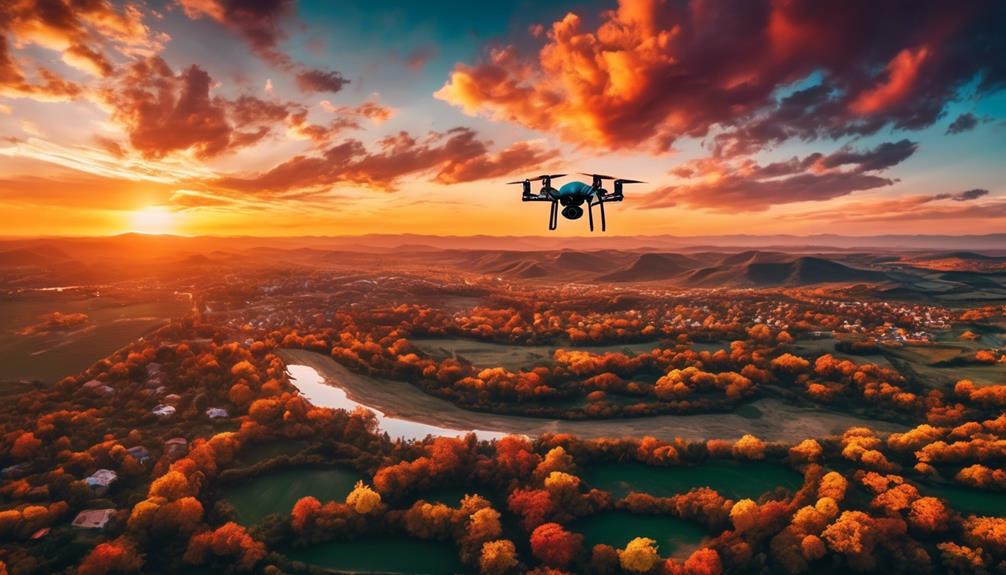Please note this post may contain affiliate links picked by me (Jay) that I have deemed may be of interest or relevant to you the reader of this.
These links do not affect the cost of the thing if you decide to purchase but i may get a little money if you choose to purchase.
For more information on my affiliate link policy click here.
As I soared my drone high above the picturesque landscape, I couldn't help but marvel at the stunning aerial views I was capturing. The world from above offered a whole new perspective, and I wanted to ensure that I captured these moments perfectly.
That's when I realized the importance of mastering the best drone photography settings. With a plethora of options available, it can be overwhelming for beginners to know where to start. But fear not, as I'm here to guide you through the three essential settings that will help you elevate your drone photography game.
Trust me, once you nail these settings, your visuals will never be the same again.
Key Takeaways
- Set the camera settings appropriately for optimal image quality, including low ISO, fast shutter speed, manual focus, and adjusted aperture.
- Make exposure and white balance adjustments to achieve balanced highlights and shadows, correct color cast, and enhance colors.
- Utilize composition and framing techniques such as the rule of thirds and leading lines to create visually compelling images.
- Take advantage of different lighting conditions and times of day, such as the golden hour and blue hour, to capture unique and atmospheric shots.
Basic Camera Settings
When diving into the world of drone photography, getting familiar with the basic camera settings is an essential first step to capturing stunning aerial shots. As a newbie in this exciting field, I was eager to learn the ropes and maximize the potential of my drone's camera. Let me share with you some key tips and recommendations to help you get started.
Firstly, let's talk about ISO and shutter speed. These two settings play a crucial role in controlling the exposure and capturing sharp images. For daytime shots, I recommend setting the ISO to its lowest value (usually around 100-200) to minimize noise and maintain image quality. As for the shutter speed, aim for a faster setting (around 1/500th of a second or higher) to freeze the motion and avoid blurry shots.
Next, let's discuss focus and depth of field. Achieving sharp focus is vital for creating impactful drone photographs. One effective technique is to use manual focus and set it to infinity. This ensures that the entire scene is in focus, from the foreground to the background. Additionally, adjusting the aperture can help control the depth of field. For landscapes, a smaller aperture (higher f-number) such as f/8 or f/11 can yield a greater depth of field, ensuring everything from the foreground to the distant horizon is in focus.
Exposure and White Balance Adjustments
Now that we've a solid understanding of the basic camera settings, let's explore the exciting realm of exposure and white balance adjustments in drone photography. These adjustments play a crucial role in capturing stunning aerial shots and can truly elevate the quality of your images. So, let's dive in and discover how to make the most of these settings!
- Exposure Adjustment: Adjusting the exposure allows you to control the amount of light that enters the camera sensor. This is especially important in drone photography as lighting conditions can vary greatly. Experiment with exposure settings to capture the perfect balance between highlights and shadows. Remember, too much exposure can result in overexposed images, while too little can make them appear dark and underexposed.
- White Balance Adjustment: White balance ensures that the colors in your photos appear natural and accurate. Drones often capture images with different color temperatures due to varying light sources. By adjusting the white balance, you can correct any color cast and achieve true-to-life colors in your images.
- Custom Filters: Custom filters are a fantastic tool for fine-tuning exposure and white balance. These filters can help reduce glare, enhance colors, and even out the exposure. Experiment with different filters to achieve the desired effect in your drone photography.
- Post Processing Techniques: In addition to adjusting exposure and white balance in-camera, post-processing techniques can further enhance your drone photographs. Software like Adobe Lightroom or Capture One allows you to fine-tune these settings and make additional adjustments to achieve the perfect look.
With a little practice and experimentation, exposure and white balance adjustments can take your drone photography to new heights. So, don't be afraid to get creative and explore the endless possibilities that these settings offer. Happy flying and capturing!
Composition and Framing Techniques
Let's explore the art of composition and framing techniques to take your drone photography to the next level. When it comes to capturing stunning aerial shots, it's not just about having the right settings and equipment; it's also about how you compose your shots and frame your subjects.
By applying the rule of thirds and utilizing leading lines, you can create visually compelling and dynamic images that will captivate your audience.
The first technique to master is the rule of thirds application. Instead of placing your subject right in the center of the frame, imagine dividing your image into a grid of nine equal parts, like a tic-tac-toe board. The idea is to position your subject along one of the imaginary lines or at the intersection points. This creates a more balanced and visually pleasing composition. Experiment with different placements and angles to find the most effective arrangement.
Another powerful technique is utilizing leading lines. These are natural or man-made lines that guide the viewer's eyes towards the main subject of your photo. They can be anything from roads, rivers, or even the edges of buildings. By positioning your drone in a way that incorporates these leading lines into your frame, you can create a sense of depth and draw attention to your subject. Experiment with different angles and heights to find the most compelling composition.
Frequently Asked Questions
Are There Any Specific Drone Models or Brands That Are Recommended for Beginners in Drone Photography?
There are many great drone models and brands that are perfect for beginners in drone photography. These recommended models offer user-friendly features and intuitive controls that make capturing stunning aerial photographs a breeze.
With these drones, you can easily adjust settings like exposure, ISO, and shutter speed to achieve the perfect shot.
How Can I Ensure That My Drone Remains Stable and Steady During Photography Sessions?
When it comes to keeping my drone steady and stable during photography sessions, I've learned a few tips and tricks that have made a world of difference.
It's like finding the perfect balance on a tightrope – you want to ensure that your drone remains rock solid in the air.
One technique I swear by is using a tripod mode, which slows down the drone's movements and makes it easier to capture steady aerial shots.
Additionally, adjusting the drone's sensitivity settings and using a gimbal can greatly improve stability.
Are There Any Legal Restrictions or Guidelines That I Should Be Aware of When Using Drones for Photography?
When it comes to drone photography, it's important to be aware of the legal restrictions and guidelines in place. These rules ensure safety and protect privacy.
Before taking flight, make sure you understand the regulations specific to your location. Familiarize yourself with airspace restrictions, flight altitude limits, and any permits or licenses required.
Additionally, be mindful of privacy concerns and respect the rights of others.
What Are Some Common Challenges or Obstacles That Beginners May Face When Starting Out With Drone Photography?
Starting out with drone photography can be a thrilling and eye-opening experience.
However, like any new endeavor, there are common challenges and obstacles that beginners may face along the way.
One of the most common challenges is learning how to control the drone effectively, especially when it comes to capturing stable and smooth footage.
Additionally, understanding the various settings and functions of the drone camera can be overwhelming at first.
But with practice and a bit of patience, these obstacles can easily be overcome, allowing you to unlock your creativity and capture stunning aerial shots.
Are There Any Post-Processing Techniques or Software That Can Enhance the Quality of Drone Photographs?
Post-processing techniques and software recommendations can greatly enhance the quality of drone photographs. There are various techniques like adjusting exposure, contrast, and saturation, as well as applying filters or using HDR imaging.
Software like Adobe Lightroom and Photoshop offer powerful tools for editing and enhancing drone photos. These post-processing techniques and software allow you to unleash your creativity and take your drone photography to the next level, resulting in stunning and professional-looking images.
Conclusion
So there you have it, fellow drone photography enthusiasts! With the right camera settings, exposure adjustments, and composition techniques, you'll be well on your way to capturing breathtaking aerial shots.
Just remember to let your creativity soar high and let your drone be your artistic companion. Embrace the power of the skies and unveil the world from a whole new perspective.
Get ready to take flight and let your passion for photography reach new heights!


